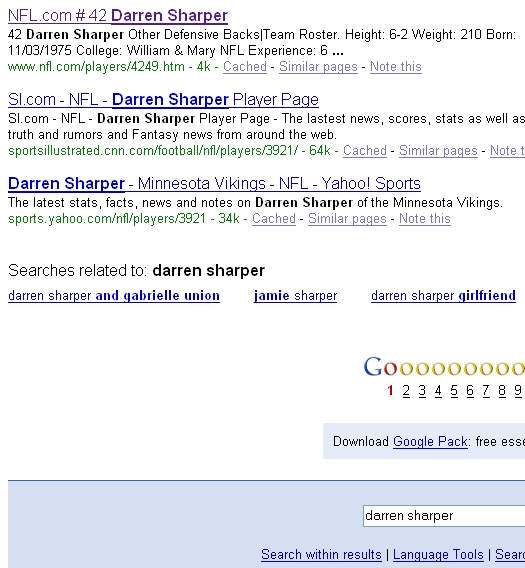The fundamentals in football are how to block, how to tackle, how to catch and how to pass. One of the fundamentals of redesigning a web site is to preserve, or at least account for, existing inbound links to the site.
So it was odd to discover after the redesign of NFL.com was unveiled amid much fanfare, that they changed the URL structure of the pages of individual football player’s profiles but failed to account for all the links that pointed to the old player profiles.
Pro Football Bloggers’ Links To NFL.com
According to Google, there are 22,800 inbound links to the root NFL.com domain. As of this writing, Technorati lists more than 67,000 blog posts linking to NFL.com. That’s a lot of links representing a lot of traffic and a major marketing blunder.
As someone who blogs quite a bit about pro football, the league’s failure to account for existing links to their site is especially annoying because all of the links I have to player profiles prior to the redesign are now broken. This is obviously lost traffic to NFL.com, but, more importantly to me, the broken links create a horrible user experience for the readers of my blog posts. They get is an error page rather than the player profile they were expecting.
The extremely frustrating thing for me is that long ago I made it policy to link to a player’s NFL profile under the reasonable assumption that the links wouldn’t change. The problem of linking to team profiles is that players change teams though trades, free agency, and cuts and that results in broken links. It’s reasonable to assume that many other football bloggers came to the same conclusion.
Perhaps I should only link to Wikipedia player bios from now on.
But it is not just links from blogs that have been broken, the links from the search engines are broken, too, and that’s a user experience and branding problem for the NFL.
NFL.com’s Search Engine Optimization
I’ll use Minnesota Vikings safety Darren Sharper to illustrate NFL.com’s previous URL structure for player profiles. The URL for Sharper’s profile on NFL.com was http://www.nfl.com/players/4249.htm. The new URL is http://www.nfl.com/players/darrensharper/profile?id=SHA500479. Note that they’ve included the player’s name in the URL itself, while the old URL only used an ID number.
As of this writing, this is what the Google search results look like for "Darren Sharper":
You’ll notice from the screenshot above that the link for Sharper’s old profile reads "NFL.com #42 Darren Sharper." That text is taken from the HTML TITLE Tag of the page. The new player profile pages use only the player’s name in the TITLE Tag. Couple that with the inclusion of the player’s name in the URL and it becomes obvious that the redesigned site is intended to be search optimized in order to boost the page’s rankings on the search engine results pages.
If the NFL knew enough to optimize the redesigned site for search engines, wouldn’t they know enough to account for existing inbound links? Apparently not.
When you click on the link to Sharper’s profile from the search results, you get an error page. That creates a frustrating user experience for NFL.com and that frustration hurts the NFL brand.
Site Redesign Fundamentals
The fundamentals for dealing with an issue that many site’s must deal with are well known and relatively painless: 1) permanent 301 redirects to seamlessly point an old page to a new one in a "search engine friendly" manner so that you do not lose your search ranking, and 2) using an XML sitemap to tell the search engines about your new pages. NFL.com does neither.
The NFL certainly doesn’t need search engines to drive traffic to
NFL.com. They’ve got television to do that. But the fact remains that
NFL.com is listed in the search engines and accounting for broken links should have been done with the redesign. It’s obvious the NFL has a pretty sizable Internet marketing budget, so you’d think their Internet marketing team would have planned for that.
Blogger Liaisons
Any organization with mass popular appeal that is likely to have a lot of people blogging about them–which is especially applicable to professional sports leagues–should think seriously of creating a blogger liaison. This person would have a blog themselves and reach out to bloggers, solicit their feedback, inform them of issues that may affect them and answer questions, etc.
An obvious example that will immediately spring to mind for those in the search marketing industry, is Matt Cutts who performs that very function for Google’s relations with the search engine marketing community.
If the NFL had a blogger liaison and informed pro football bloggers about an upcoming site redesign, I’m absolutely certain those bloggers would have worried about broken links and the NFL would have become aware of the issue prior to the launch of their redesigned site.
The e-Strategy Academy covers all aspects of digital marketing including search optimization & marketing, email marketing, social media marketing, video marketing, mobile marketing & public relations.

